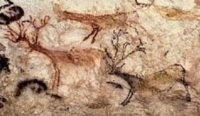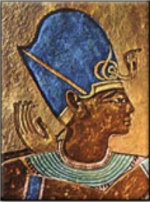 |
Chemistry
Colours, Pigments and Dies |
Research Proposals for 2003 - Group
E |
Introduction:
Colours have been used for decorative purposes since prehistoric times. To
produce decorative colour effects pigments and dyes are used.
|
Historical overview:
The first cultural use of colour is lost in the depths of unrecorded history.
It may have taken place as early as half a million years ago or more and involved
body painting. About a hundred thousand years ago, early humans started using
red ochre in burial and fertility rites, possibly as a symbolic replacement
for blood. |

Ocher in mineral form |
Some thirty thousand years ago humans learned how to
grind minerals and to mix them with liquids and apply them to stone
surfaces as a pigment. The most dramatic example of these early painting
techniques can be found in caves in France (Lascaux and Chauvet).
The colours were relatively muted and their palette contained no blues, greens
or bright colours. |
 |
|
|
Cave paintings in Lascaux
|
| The rise of civilisation around the Mediterranean, including
Egypt, Crete, Greece and Rome brought the discovery of the missing colours.
These people utilised different minerals as well as insects, snails and
certain shellfish to produce a wide variety of different pigments in
bright colours. Initially the pigments used were mainly inorganic substances
but later on the use of organic substances resulted in the use of blue
indigo dye and red henna. |
 |
|
|
Egyptian blue in powder form |
| A depiction of King Ramses III�(helmet coloured with Egyptian blue
pigment) |
|
Slow progress in the post-Roman era laid the groundwork
for the dramatic discoveries of synthetic pigments and dyes during
the 19th century. Synthetic materials now dominate the colour industry.
Chemists have learned how to make chemical alterations in molecules
in order to produce essentially any desired hue and to control the
properties of fastness and solubility.
Chemistry of Dies and Pigments:
These ancient pigments and dyes may be found in a variety of different
artefacts ranging from shards of pottery to precious bits of cloth.
The different dyes substances can be identified by chemical analysis.
X-ray diffraction techniques can be used to identify the inorganic
components that constitute ancient pigments and dyes. Organic dyes
can be identified by mass spectra or absorption spectra in the visible
and ultra violet range.
Aim of the project:
-
Historical overview of pigment use by doing web
research.
-
Identification of different pigments in nature
and collection of some raw materials. (Possible fieldtrip?)
-
Laboratory analysis of ancient pigments by use
of IR FTIR and UV. (Pottery and glass samples provided by Archaeology
department)
-
Preparation of pigments and dyes by laboratory
simulation of ancient techniques. (Dying fabric with indigo – one
of the oldest fabric dyes used and making Egyptian Blue coloring)
-
Investigating modern processes of pigment and
dye manufacturing in the Chemical industry. (Web research and possible
expert for talk.)
|
Participants
- Prof. Jan Boeyens
- Ms. Danita de Waal
- Ms. Monica van der Merwe
|
|
|